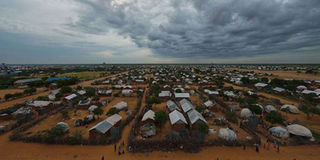UN scaling back Dadaab operations as population and funding decline

An aerial view of a section of the Dadaab refugee camp in Kenya. In recent weeks, 832 Somali refugees were flown to Kismayu and 83 to Mogadishu, the UN says. PHOTO | AFP
What you need to know:
The size of the refugee complex continues to contract but not at the pace demanded by the Kenyan government, which has said repeatedly that it wants Dadaab to be closed entirely.
Voluntary returns of refugees to Somalia from Dadaab total nearly 32,000 so far this year and more than 71,000 since the launch of a joint UN/Kenya/Somalia repatriation initiative in 2014.
Another 17,229 refugees have registered to return to Somalia, the UN reports.
A steep drop in funding and a steady decrease in population are leading the United Nations to scale back its operations in the Dadaab camps, the UN refugee agency said on Thursday.
The total number of the mainly Somali residents of Dadaab has been reduced by nearly half in recent years — from 464,500 in 2011 to 240,000 as of mid-September, according to the UN.
OFFICE
The budget for the camps has been cut by 70 percent during the same period, said UN refugee agency spokeswoman Yvonne Ndege.
As a result, the UN plans to close its Alinjugur field office in Dadaab by next March.
That move has sparked protests on the part of residents who fear a loss of services, the Nation reported on Tuesday.
The refugee agency has also cut its funding for the Fafi Integrated Development Association (Faida), an NGO focused on agricultural projects and cookstove provision in Dadaab.
“Given the ongoing consolidation efforts, it has also been deemed prudent to consolidate implementation arrangements, given reduced resources,” Ms Ndege wrote in an email in response to a Nation query about UN funding for Faida.
WFP
Refugees in Kenya are also facing reduced allotments of nutritional foods and a possible overall reductions in rations, the UN's World Food Programme (WFP) warned on Wednesday.
Due to funding shortfalls for its work in Kenya, WFP said “supercereal” is no longer being provided to refugees.
“If no substantial resources are received soon, WFP will be compelled to introduce rations cuts from October in order to stretch available resources through December,” the agency added.
The size of the refugee complex continues to contract but not at the pace demanded by the Kenyan government, which has said repeatedly that it wants Dadaab to be closed entirely.
Voluntary returns of refugees to Somalia from Dadaab total nearly 32,000 so far this year and more than 71,000 since the launch of a joint UN/Kenya/Somalia repatriation initiative in 2014.
REPATRIATIONS
Another 17,229 refugees have registered to return to Somalia, the UN reports.
Voluntary repatriations are taking place solely by air at present, limiting the number of repatriations.
In recent weeks, 832 Somali refugees were flown to Kismayu and 83 to Mogadishu, the UN says.
Smaller numbers of refugees are filing for repatriation, however.
SERVICES
“Due to suspension of road movements, and returns to Baidoa being put on hold until further notice, the Return Help Desks continue to receive a reduced number of persons seeking return,” the UN said in its latest update on Dadaab operations.
The refugee agency is meanwhile pledging to maintain or increase services in Dadaab and in nearby Kenyan towns.
“We will continue to support host communities, with a particular focus on long-term interventions, for which we are seeking the support of various development partners,” Ms Ndege said on Thursday.
She cited plans to establish a technical training institute in Alinjugur, a public health institute in Dadaab's Ifo2 camp and enhancement of the referral hospital in the refugee complex.





